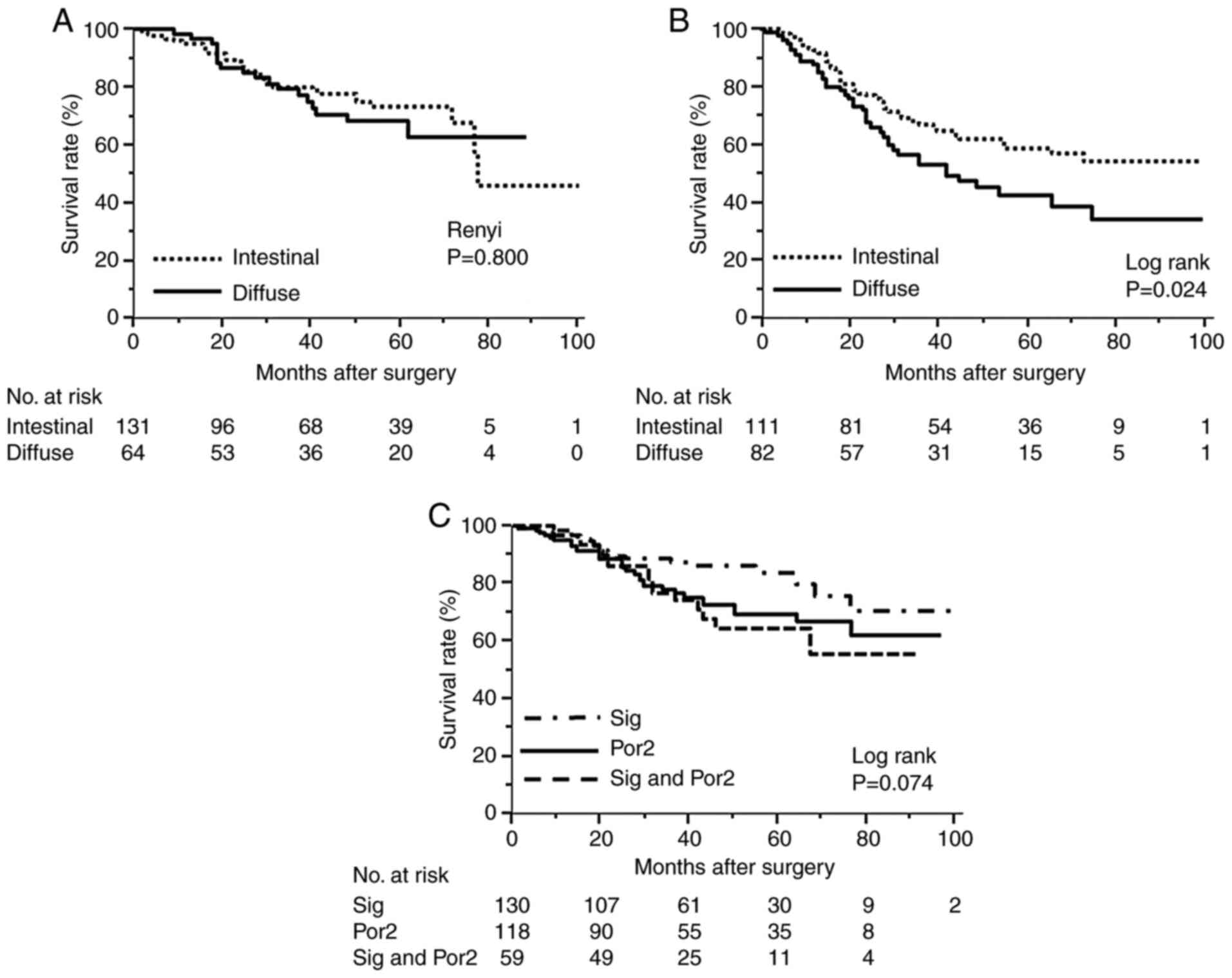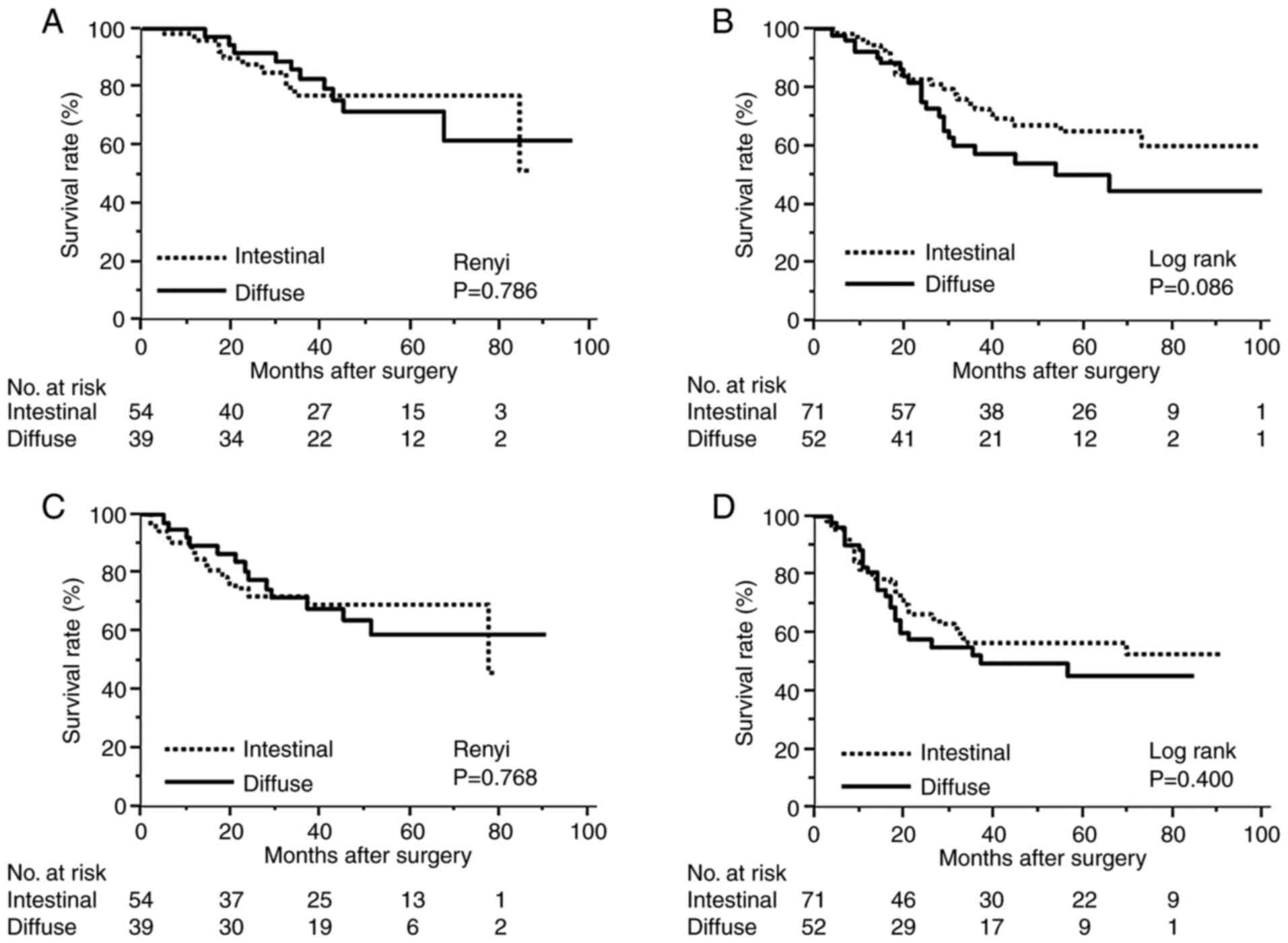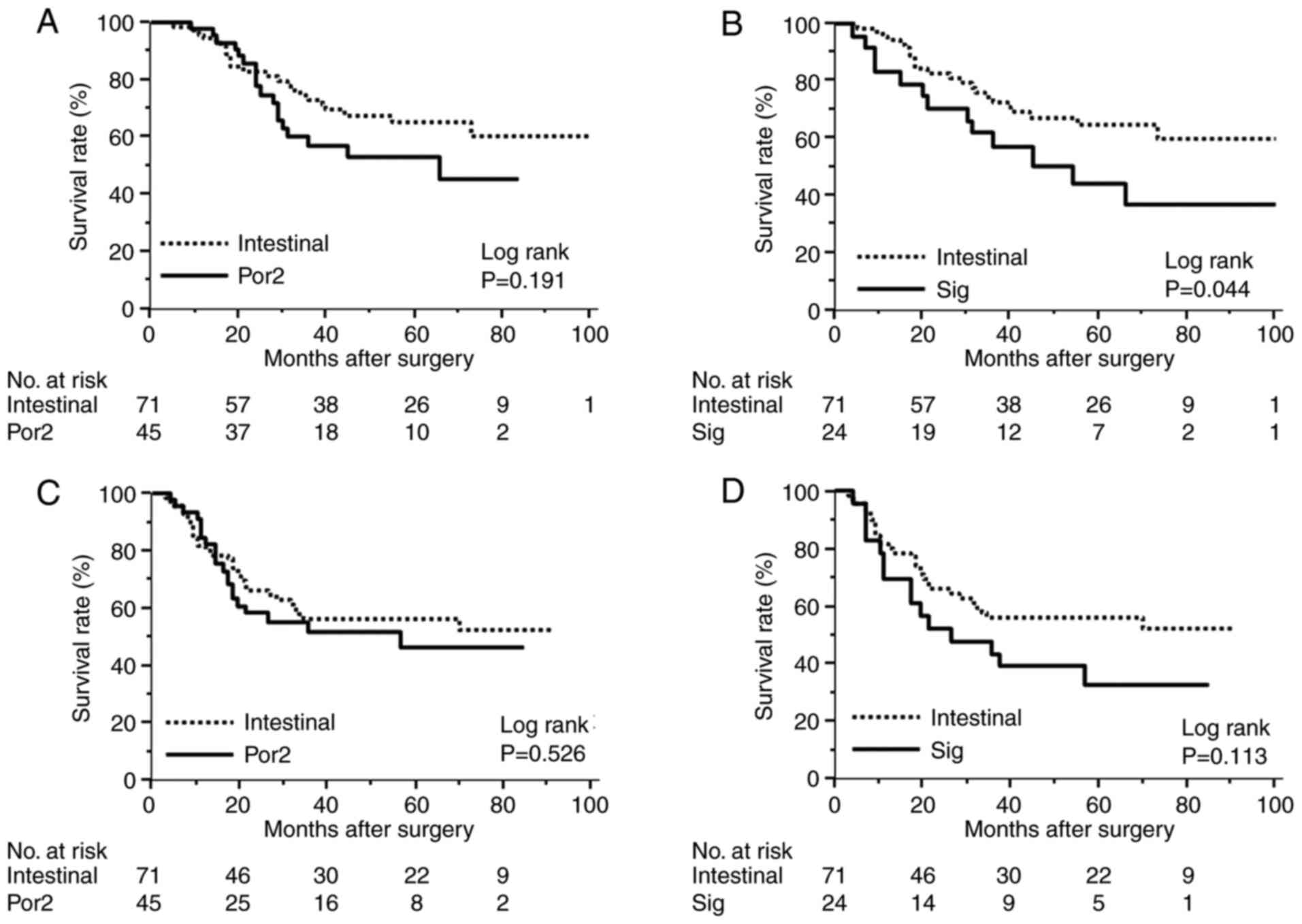|
1
|
Lauren P: The two histological main types
of gastric carcinoma: Diffuse and so-called intestinal-type
carcinoma. An attempt at a histo-clinical classification. Acta
Pathol Microbiol Scand. 64:31–49. 1965.PubMed/NCBI View Article : Google Scholar
|
|
2
|
Japanese Gastric Cancer Association.
Japanese classification of gastric carcinoma: 3rd English edition.
Gastric Cancer. 14:101–112. 2011.PubMed/NCBI View Article : Google Scholar
|
|
3
|
Nagtegaal ID, Odze RD, Klimstra D, Paradis
V, Rugge M, Schirmacher P, Washington KM, Carneiro F and Cree IA:
WHO Classification of Tumours Editorial Board. The 2019 WHO
classification of tumours of the digestive system. Histopathology.
76:182–188. 2020.PubMed/NCBI View Article : Google Scholar
|
|
4
|
Lee JH, Chang KK, Yoon C, Tang LH, Strong
VE and Yoon SS: Lauren histologic type is the most important factor
associated with pattern of recurrence following resection of
gastric adenocarcinoma. Ann Surg. 267:105–113. 2018.PubMed/NCBI View Article : Google Scholar
|
|
5
|
Chen YC, Fang WL, Wang RF, Liu CA, Yang
MH, Lo SS, Wu CW, Li AFY, Shyr YM and Huang KH: Clinicopathological
variation of lauren classification in gastric cancer. Pathol Oncol
Res. 22:197–202. 2016.PubMed/NCBI View Article : Google Scholar
|
|
6
|
Sasako M, Sakuramoto S, Katai H, Kinoshita
T, Furukawa H, Yamaguchi T, Nashimoto A, Fujii M, Nakajima T and
Ohashi Y: Five-year outcomes of a randomized phase III trial
comparing adjuvant chemotherapy with S-1 versus surgery alone in
stage II or III gastric cancer. J Clin Oncol. 29:4387–4393.
2011.PubMed/NCBI View Article : Google Scholar
|
|
7
|
Yoshida K, Kodera Y, Kochi M, Ichikawa W,
Kakeji Y, Sano T, Nagao N, Takahashi M, Takagane A, Watanabe T, et
al: Addition of docetaxel to oral fluoropyrimidine improves
efficacy in patients with stage III gastric cancer: Interim
analysis of JACCRO GC-07, a randomized controlled trial. J Clin
Oncol. 37:1296–1304. 2019.PubMed/NCBI View Article : Google Scholar
|
|
8
|
Petrelli F, Berenato R, Turati L, Mennitto
A, Steccanella F, Caporale M, Dallera P, de Braud F, Pezzica E, Di
Bartolomeo M, et al: Prognostic value of diffuse versus intestinal
histotype in patients with gastric cancer: A systematic review and
meta-analysis. J Gastrointest Oncol. 8:148–163. 2017.PubMed/NCBI View Article : Google Scholar
|
|
9
|
Cancer Genome Atlas Research Network.
Comprehensive molecular characterization of gastric adenocarcinoma.
Nature. 513:202–209. 2014.PubMed/NCBI View Article : Google Scholar
|
|
10
|
Cristescu R, Lee J, Nebozhyn M, Kim KM,
Ting JC, Wong SS, Liu J, Yue YG, Wang J, Yu K, et al: Molecular
analysis of gastric cancer identifies subtypes associated with
distinct clinical outcomes. Nat Med. 21:449–456. 2015.PubMed/NCBI View
Article : Google Scholar
|
|
11
|
Cislo M, Filip AA, Arnold Offerhaus GJ,
Ciseł B, Rawicz-Pruszyński K, Skierucha M and Polkowski WP:
Distinct molecular subtypes of gastric cancer: From Lauren to
molecular pathology. Oncotarget. 9:19427–19442. 2018.PubMed/NCBI View Article : Google Scholar
|
|
12
|
Zheng HC, Li XH, Hara T, Masuda S, Yang
XH, Guan YF and Takano Y: Mixed-type gastric carcinomas exhibit
more aggressive features and indicate the histogenesis of
carcinomas. Virchows Arch. 452:525–534. 2008.PubMed/NCBI View Article : Google Scholar
|
|
13
|
Fujimoto A, Ishikawa Y, Ishii T, Yamada A,
Igarashi Y, Ohmoto Y and Kaise M: Differences between gastric
signet-ring cell carcinoma and poorly differentiated
adenocarcinoma: A comparison of histopathologic features determined
by mucin core protein and trefoil factor family peptide
immunohistochemistry. Pathol Int. 67:398–403. 2017.PubMed/NCBI View Article : Google Scholar
|
|
14
|
Pernot S, Voron T, Perkins G,
Lagorce-Pages C, Berger A and Taieb J: Signet-ring cell carcinoma
of the stomach: Impact on prognosis and specific therapeutic
challenge. World J Gastroenterol. 21:11428–11438. 2015.PubMed/NCBI View Article : Google Scholar
|
|
15
|
Li C, Kim S, Lai JF, Hyung WJ, Choi WH,
Choi SH and Noh SH: Advanced gastric carcinoma with signet ring
cell histology. Oncology. 72:64–68. 2007.PubMed/NCBI View Article : Google Scholar
|
|
16
|
Chon HJ, Hyung WJ, Kim C, Park S, Kim JH,
Park CH, Ahn JB, Kim H, Chung HC, Rha SY, et al: Differential
prognostic implications of gastric signet ring cell carcinoma:
stage adjusted analysis from a single high-volume center in Asia.
Ann Surg. 265:946–953. 2017.PubMed/NCBI View Article : Google Scholar
|
|
17
|
Lee SH, Jee SR, Kim JH and Seol SY:
Intramucosal gastric cancer: The rate of lymph node metastasis in
signet ring cell carcinoma is as low as that in well-differentiated
adenocarcinoma. Eur J Gastroenterol Hepatol. 27:170–174.
2015.PubMed/NCBI View Article : Google Scholar
|
|
18
|
Machlowska J, Puculek M, Sitarz M,
Terlecki P, Maciejewski R and Sitarz R: State of the art for
gastric signet ring cell carcinoma: From classification, prognosis,
and genomic characteristics to specified treatments. Cancer Manag
Res. 11:2151–2161. 2019.PubMed/NCBI View Article : Google Scholar
|
|
19
|
Piessen G, Messager M, Leteurtre E,
Jean-Pierre T and Mariette C: Signet ring cell histology is an
independent predictor of poor prognosis in gastric adenocarcinoma
regardless of tumoral clinical presentation. Ann Surg. 250:878–887.
2009.PubMed/NCBI View Article : Google Scholar
|
|
20
|
Yoshii M, Tanaka H, Ohira M, Muguruma K,
Iwauchi T, Lee T, Sakurai K, Kubo N, Yashiro M, Sawada T and
Hirakawa K: Expression of Forkhead box P3 in tumour cells causes
immunoregulatory function of signet ring cell carcinoma of the
stomach. Br J Cancer. 106:1668–1674. 2012.PubMed/NCBI View Article : Google Scholar
|
|
21
|
Jimenez Fonseca P, Carmona-Bayonas A,
Hernandez R, Custodio A, Cano JM, Lacalle A, Echavarria I, Macias
I, Mangas M, Visa L, et al: Lauren subtypes of advanced gastric
cancer influence survival and response to chemotherapy: Real-world
data from the AGAMENON national cancer registry. Br J Cancer.
117:775–782. 2017.PubMed/NCBI View Article : Google Scholar
|
|
22
|
Yoon C, Cho SJ, Aksoy BA, Park DJ, Schultz
N, Ryeom SW and Yoon SS: Chemotherapy resistance in diffuse-type
gastric adenocarcinoma is mediated by RhoA activation in cancer
stem-like cells. Clin Cancer Res. 22:971–983. 2016.PubMed/NCBI View Article : Google Scholar
|
|
23
|
Takahari D, Boku N, Mizusawa J, Takashima
A, Yamada Y, Yoshino T, Yamazaki K, Koizumi W, Fukase K, Yamaguchi
K, et al: Determination of prognostic factors in Japanese patients
with advanced gastric cancer using the data from a randomized
controlled trial, Japan clinical oncology group 9912. Oncologist.
19:358–366. 2014.PubMed/NCBI View Article : Google Scholar
|
|
24
|
Koizumi W, Kim YH, Fujii M, Kim HK,
Imamura H, Lee KH, Hara T, Chung HC, Satoh T, Cho JY, et al:
Addition of docetaxel to S-1 without platinum prolongs survival of
patients with advanced gastric cancer: A randomized study (START).
J Cancer Res Clin Oncol. 140:319–328. 2014.PubMed/NCBI View Article : Google Scholar
|

















